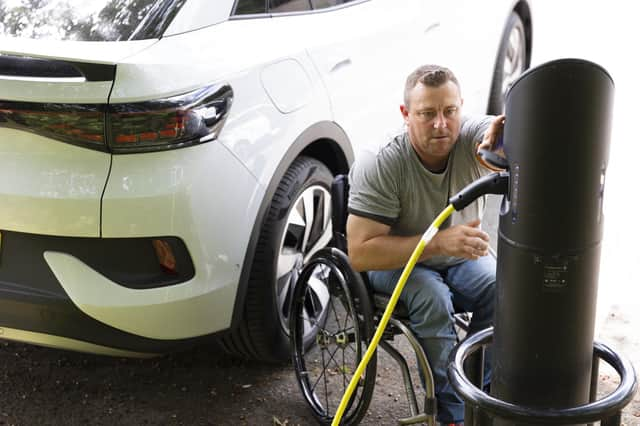Supporting disabled people in the move to electric vehicles


And disabled people are being supported in their sustainability ambitions by Motability Operations, the UK company that runs the Motability car, powered wheelchair and scooter scheme for 700,000 customers in the UK, with more than 70,000 in Scotland.
The organisation has committed £300 million to support customers making the switch to electric, with investment and innovation projects to make EVs more affordable, available and accessible. Motability Operations believes the majority of its customers are open to switching to EVs, but its research shows many need support to make sure of a transition that works for everyone.
Jonathan Jenkins, head of innovation at Motability Operations, says: “The industry is going through a huge mobility transition and EVs are really the first part of that. We must make sure our customers don’t get left behind during this transition. We currently have around 34,000 customers with EVs and eventually we will need to help them all make the switch. The first step is to understand the barriers and concerns, and then work to help address them.”
“To ease the transition, we need to start by focusing on education as there are a lot of people who don’t know much about EVs. We provide our customers with impartial information and guidance. We’re currently trialing the benefits of offering customers an immersive experience in this new technology, for example by providing them with an EV to try for an extended period. We want to provide good pricing for our customers and plenty of availability.”
The cost of EVs has been identified as a concern for customers and Motability Operations is using its investment and relationships with manufacturers to help drive greater affordability. The Scheme’s latest list features its biggest ever number of affordable and longer-range EVs, with over 120 now available.
Motability Operations has found that after range anxiety, the biggest blocker to adoption is concern over the public charging infrastructure. The company says the current fragmented charging ecosystem needs simplifying to support its customers.
“Our customers tend to be on a lower income and often don’t have access to off-street parking which makes it difficult to have a home charger,” explains Jenkins.
Charging an EV away from home has been identified as a “critical customer pain point” by Motability Scheme customers. Some 35% of those surveyed said they had trouble locating a suitable charge point and more than half experienced problems when trying to pay. Therefore Motability has innovated to address this problem with the creation of its Go Charge payment solutions app which lets customers find a charge point, charge their EV and pay all in one place. The company is building the capability to add credit to a customer’s Go Charge account and working with industry to negotiate discounts.
Jenkins adds: “We know that there’s much more to be done to make public charging inclusive and accessible, so we’re developing a tool that supports our customers to find the right charge point for them so they can better plan their journeys. Customers will soon be able to access the Motability Go app, which is a bit like TripAdvisor for charging points, look at pictures and rate them across different measures of accessibility. We hope our customers will use the app to locate a charge point that meets their specific requirements.”
Jenkins explains that Motability is also looking to influence the location of public charge points. “For example, if we know we have a significant footprint of customers in a certain city where there will be limited access to home chargers, we’ll work with the industry to encourage them to concentrate the roll-out of public charge points in those areas.”
Looking further ahead, Jenkins says: “We’re also looking to explore bi-directional charging at the homes of some customers. This would allow them to charge their car overnight when there is less demand on the grid and energy is cheaper, and use their car during the day to help power their home. This means an EV is helping a customer manage their energy costs and supporting the grid’s transition to renewable energy. We’re also exploring the possibilities of community charging which would help those living in flats or terraced houses. Charge point owners could generate income by letting others book and access their home charger at a cheaper cost than network charging. As an innovation team, it's really important that we understand how we can support our customers to maximise the potential of new technology in electric vehicles.”
Future proofing customers’ mobility and independence is essential to the company and the team is keeping a close eye on the development of future transport zones in the UK, where the aggregation of public and private transport, known as MaaS (Mobility as a Service), is being established. One example of a MaaS solution currently being developed in the Highlands and Islands of Scotland by technology firm Mobilleo is the GoHi app. The app integrates a variety of transit modes, journey planning tools and payment functionality.
Jenkins concludes: “We know that some disabled people approach public transport with a certain degree of caution, or anxiety. We want to work with companies like Mobilleo to ensure our customers don’t get left behind when new products such as MaaS zones are being developed.”
You can read more about Motability here.